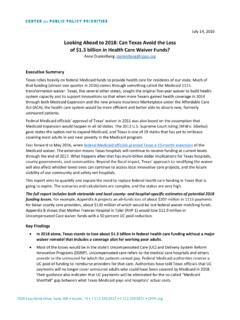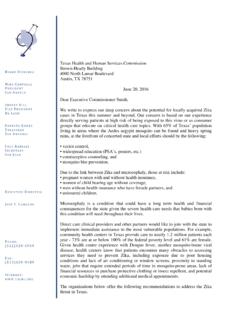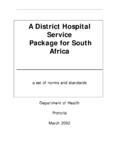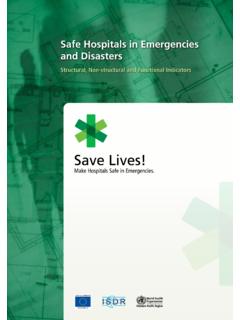Transcription of Surprise Medical Bills Take Advantage of Texans
1 September 15, 2014 Surprise Medical Bills Take Advantage of Texans : Little-known practice creates a "second emergency" for ER patients Stacey Pogue, and Megan Randall Most of us will end up in an emergency room at some point. And when we do, we ll probably have no choice which physicians treat us and no ability to ensure they are part of our insurance company s network of preferred providers. Texas consumers may reasonably expect that if treated in an in- network hospital in an emergency, the physicians practicing within that hospital would also be in that same network . This is too often not the case, leaving consumers vulnerable to Surprise Medical Bills , known as balance Bills , from out-of- network physicians based at hospitals. While the practice is little-known to consumers, those who have received Surprise Medical Bills often recount in anger how much money they paid and the frustrations of trying to understand and resolve billing issues with doctors and insurers.
2 This report analyzes what leads to unexpected balance Bills and explores recommendations to correct this practice. What is balance billing ? Balance billing occurs when a consumer receives out-of- network health care services and is directly billed by the provider for the balance of what the insurer didn t pay in other words, the difference between the provider s billed charge and the amount the insurer pays. This difference, as illustrated in Figure 1, can be quite large. Why does balance billing happen? In many cases the physicians practicing within a hospital are not employees of the hospital and do not necessarily participate in the same insurance plans as the hospital. This may come as a Surprise to many consumers since hospital-based care is delivered and billed for under a different model than most consumer services. Imagine going out to eat and receiving separate Bills from the restaurant, host, waiter, cook, and busboy, some of whom were willing to negotiate discounts or accept coupons, while others were not.
3 Hospitals commonly make arrangements with individual physicians and/or a physician group(s) to provide Medical services within the hospital. For example, a hospital may contract with one or more groups of emergency room physicians to provide services within the emergency room. Similar arrangements may be made with outside groups of doctors to provide anesthesiology, radiology, pathology, and neonatology services within the hospital. These groups of physicians, who are not hospital employees, decide independently which insurance plans to participate in and often do not participate in all of the same insurance plans that the hospital does. In practice, this means a trip to the emergency room will likely result in multiple separate Bills from different providers and may result in receiving (and being billed for) out-of- network physician services even if a consumer goes to an in- network hospital. This is one way consumers who think they are using an in- network provider still end up with an unexpected balance bill.
4 2 Most Texans with private insurance are enrolled in Preferred Provider Organization (PPO) plans, in which consumers save money if they get their care within a specified network of providers. If you stay in- network , you will have a lower deductible and copayments. You can see doctors outside of the network , but your out-of-pocket costs will be higher. Providers within an insurer s network have agreed to accept the insurer s reimbursement as payment in full. But out-of- network providers have not agreed to accept an insurer s rates and may expect to receive their full billed charges. Texas has some protections in place that lessen the impact of Surprise Bills stemming from emergency room visits, but these protections do not prohibit balance Bills . The best solution for consumers in a Medical emergency is to stay out of billing disputes between insurers and out-of- network providers. The Texas Legislature can remove consumers from the billing disputes by patching the gaps in Texas successful, but tightly limited, balance-billing mediation process.
5 Figure 1: Illustration of a Consumer s Cost for In- and Out-of- network Care Threat to family financial security Surprise Medical Bills that can run into the hundreds or thousands of dollars are difficult for most families to afford. But for low-income families, an unexpected Medical bill can threaten the family s economic security. It could mean getting behind on other financial obligations or being sent to collections and the related, long-lasting damage to a person s credit history. Or it could be the final 3 straw that triggers bankruptcy. With more low-income families moving into private insurance through the Affordable Care Act, it becomes even more important that Texas continues working to find meaningful solutions to stop balance billing. How common is balance billing? Texas Department of Insurance (TDI) regulations that took effect in July 2013 direct Texas insurers to for the first time publish PPO plan out-of- network service data by network hospital for specific hospital-based physician types, including emergency room doctors.
6 Specifically insurers must publish the percentage of dollars billed as out-of- network by emergency room physicians within each in- network hospital as well as identify any in- network hospitals that have no in- network emergency room physicians at their hospital. These new data, summarized in Table 1 for the three largest insurers in Texas, do not directly showcase the magnitude of balance billing in Texas. They can, however, help illustrate the likelihood of a consumer being treated by an out-of- network physician at an in- network emergency room and potentially getting a Surprise bill as a result. What does this mean for consumers? Whether you get a balance bill after an emergency room trip is a roll of the dice for consumers. Insured consumers face a decent chance that they will be treated by an out-of- network emergency room physician, even if they go to an in- network hospital. Emergency room physicians at in- network hospitals bill a significant portion of services out-of- network , increasing out-of-pocket costs for consumers and the likelihood of unexpected balance Bills .
7 Of the state s three largest insurers, United Healthcare and its network hospitals top the list with an eye-opening average of 68 percent of emergency room physician charges billed out-of- network for services delivered at an in- network hospital. Table 1: Out-of- network Emergency Room Physician Services at In- network Hospitals Insurer Average Percentage of Dollars Billed Out-of- network for Emergency Room Physician Services at In- network Hospitals Percentage of In- network Hospitals with No In- network Emergency Room Physicians United Healthcare 68% 45% Humana 42% 56% Blue Cross Blue Shield 41% 21% CPPP analysis of data supplied by Texas three largest health and accident insurers by market share according to the Texas Department of Insurance, 2013 Annual Report, Part II, p. 49, Data reflect billing and providers associated only with in- network hospitals that offer emergency room services, as indicated by insurers.
8 Average share of out-of- network billing calculated as the mean percentage of dollars billed out-of- network by each in- network hospital. Sources: Blue Cross Blue Shield, Provider Finder: Important Message About Hospital-Based Physicians, Blue Choice PPO, accessed July 2014 at Average percentage of dollars billed over the course of 2013; percentage with no in- network provider current as of July, 2014. United Healthcare, Texas Facility Based Physician Contract Status, 05 March 2014, accessed 14 August 2014 at Data provided in March, 2014. Date ranges or current as of information not provided. Humana, Hospital Based Physicians, Texas PPO English, accessed 14 August 2014 at Average percentage of dollars billed over the course of 2012; percentage with no in- network provider current as of October 2013. 4 A staggering percentage of in- network hospitals with emergency rooms have NO in- network emergency room physicians available, guaranteeing that all emergency physician treatment will be performed by out-of- network doctors.
9 For example, a hospital might be in an insurer s PPO network , but NONE of the dozens of emergency physicians practicing within the emergency room have contracted to accept the insurer s reimbursement rates. Of the state s three largest insurers, Humana and its network hospitals top the list with 56 percent of network hospitals having NO in- network emergency room physicians. Even with Blue Cross Blue Shield, the best performing of the three in this category, one-in-five network hospitals have no in- network emergency physicians. Disturbingly, 8 percent of hospitals (23 of 276 hospitals) that contract with ALL 3 insurers have NO in- network emergency room physicians with any of the three insurers meaning emergency room physicians at these hospitals (listed in Table 2) are not in the PPO networks of any of Texas three largest insurers. As a result, a large percentage of insured patients who use these hospitals emergency rooms may get unexpected doctor Bills that are substantially higher than the emergency room co-payments they would expect under the terms of their insurance plan.
10 Table 2: Hospitals In- network with Each of Texas Three Largest Insurers, but with No In- network Emergency Room Physicians for Any of the Three Largest Insurers Hospital City METHODIST HOSPITAL FOR SURGERY Addison CARE REGIONAL Medical CENTER Aransas Pass CORPUS CHRISTI Medical CENTER - BAY AREA Corpus Christi CORPUS CHRISTI Medical CENTER DOCTORS REGIONAL Corpus Christi BAYLOR UNIVERSITY Medical CENTER Dallas WISE REGIONAL HEALTH SYSTEM Decatur TEXOMA Medical CENTER Denison FORT DUNCAN Medical CENTER Eagle Pass DALLAS Medical CENTER, LLC Farmers Branch HARLINGEN Medical CENTER, LP Harlingen VALLEY BAPTIST Medical CENTER Harlingen SOUTH TEXAS REGIONAL Medical CENTER Jourdanton DOCTORS HOSPITAL OF LAREDO Laredo MEMORIAL Medical CENTER LIVINGSTON Livingston MEMORIAL Medical CENTER LUFKIN Lufkin WOODLAND HEIGHTS Medical CENTER Lufkin RIO GRANDE REGIONAL HOSPITAL McAllen PARKVIEW REGIONAL HOSPITAL Mexia MIDLAND MEMORIAL HOSPITAL Midland OAKBEND Medical CENTER Richmond/Sugar Land MEMORIAL Medical CENTER - SAN AUGUSTINE San Augustine METHODIST HEALTH CENTER SUGARLAND Sugarland TOMBALL REGIONAL HOSPITAL Tomball CPPP analysis of data supplied by Texas three largest health and accident insurers by market share according to the Texas Department of Insurance.









